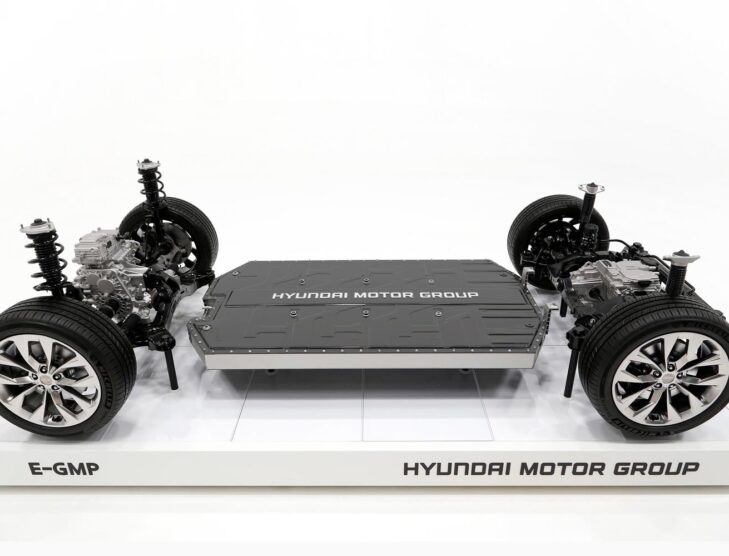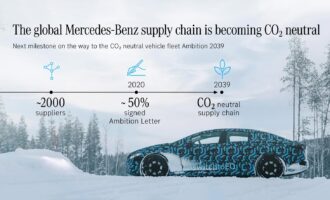
Hyundai Motor announces dedicated EV platform ‘E-GMP’
South Korea’s Hyundai Motor Group has unveiled its new Electric-Global Modular Platform (E-GMP), a dedicated battery electric vehicle (BEV) platform. Revealed during an ‘E-GMP Digital Discovery’ online event, the platform will serve as the core technology for Hyundai Motor Group’s next-generation BEV line-up.
The event was broadcasted through the Group’s official YouTube channel and Channel Hyundai, an online global content platform.
From 2021, the E-GMP will underpin a range of dedicated new BEVs, including Hyundai Motor Company’s IONIQ 5; Kia Motors Corporation’s first dedicated BEV to be revealed in 2021; and a series of other models.
Designed exclusively for BEVs, E-GMP provides various advantages compared to the Hyundai Motor Group’s existing platforms, which have each been engineered predominantly to accommodate internal combustion engines. Benefits include increased development flexibility, powerful driving performance, increased driving range, strengthened safety features, and more interior space for occupants and luggage.
“Today our front-wheel driven Hyundai and Kia BEVs are already among the most efficient ones in their segments,” said Albert Biermann, president and head of R&D Division for Hyundai Motor Group. “With our rear-wheel driven based E-GMP, we are extending our technological leadership into segments where customers demand excellent driving dynamics and outstanding efficiency.”
“E-GMP is the culmination of years of research and development and brings together our most cutting-edge technologies. Our BEV line-up will evolve and be strengthened by this innovative new platform,” said Fayez Abdul Rahman, Senior Vice President of Vehicle Architecture Development Center for Hyundai Motor Group.
Maximising development flexibility through modularisation and standardisation
E-GMP reduces complexity through modularisation and standardisation, allowing rapid and flexible development of products which can be used across most vehicle segments, such as sedans, SUVs and CUVs. Moreover, flexible development can satisfy various customer needs for vehicle performance. Among these, a high performance model will accelerate from zero to 100kph in less than 3.5 seconds and achieve a maximum speed of 260km/h.
E-GMP will be highly effective in expanding the Hyundai Motor Group’s EV leadership position as it will enable the company to enlarge its EV line-up over a relatively short period through modularization and standardization.
Designed for driving performance, safety and maximised space
E-GMP is engineered to offer improved cornering performance and driving stability at high speed. This is due to optimal weight distribution between front and rear, a design which enables a low center of gravity thanks to its low-mounted battery pack, and the adoption of electric motors located in the space previously occupied by an engine.
The high-speed electric motor raises the driving performance of E-GMP vehicles. A five-link rear suspension system, which is typically used for mid and large sized vehicle segments, and the world’s first mass-produced integrated drive axle (IDA), which combines wheel bearings with the drive shaft to transmit power to the wheels, enhance ride comfort and handling stability.
The platform secures battery safety through a battery support structure made of ultra-high strength steel. Hot-stamped steel components surround this structure for additional rigidity. Collision energy can be absorbed efficiently thanks to energy-absorbent sections of the body and chassis, effective energy load paths, and a central section of the battery pack tightly bound to the vehicle body.
Moreover, by strengthening the structure of the load support section, located in front of the dashboard, engineers have been able to minimize collision energy to the power electric system and battery. The A-pillar’s load distribution structure also prevents deformation of the passenger cell.
E-GMP maximises interior space through its long wheelbase, short front and rear overhangs and slim cockpit module. With the battery pack mounted beneath the floor, the E-GMP creates a flat floor for the cabin. This provides more legroom for passengers, while enabling various arrangements for the front and rear seats.
The battery pack itself – mounted between the front and rear wheel axles – will be the most power-dense system that Hyundai Motor Group has ever created. This is partly thanks to its enhanced cooling performance, a result of a new separate cooling block structure which helps make the battery pack more compact. With energy density enhanced by around 10% compared to existing EV battery technology, the battery packs are lighter, can be mounted lower in the body, and liberate more cabin space.
Efficient and powerful electrification system
The E-GMP’s compact new power electric (PE) system consists of a powerful motor, EV transmission and inverter. These three components are integrated into a single compact module. This ensures powerful performance by raising the motor’s maximum speed by up to 70% compared to existing motors. The high-speed motor is smaller than other motors while providing comparable performance, and it gives efficiencies in both space and weight.
Additionally, a standardised battery system can be tuned to offer performance appropriate for a specific vehicle segment, to maximize driving range, or to meet various customer needs.
The motor is controlled by the inverter power module, which adopts silicon carbide (SiC) semiconductors. This motor can enhance system efficiency by around 2~3%, which means the vehicle can be driven for approximately 5 percent longer on the same battery energy.
E-GMP relies on the rear wheel for propulsion. Customers will be able to choose between rear-wheel and all-wheel drive configurations; models with the latter can be equipped with an additional motor. The all-wheel drive system includes an EV transmission disconnector, which can control the connection between the additional motor and front wheels, and switch between two-wheel and all-wheel drive modes to enhance efficiency by offering the ideal level of power or performance for current driving conditions.
All vehicles developed with the E-GMP platform use a standardised single type of battery module. This module is composed of pouch-type standard cells and can be packed in different quantities as required for each vehicle.
Multi (800V and 400V) and bi-directional charging system
Most existing EVs and the fast-charging infrastructure provide 50kW~150kW charging for EVs equipped with a 400V system; however, the development of 800V infrastructure, with up to 350kW charging, will gradually enable even more fast-charging.
In line with this trend, Hyundai Motor Group has invested in IONITY, Europe’s leading high-power charging network, as a strategic partner and shareholder. IONITY operates 308 high-power charging (HPC) stations – using a charging capacity of up to 350 kW – along highways in European countries. The company plans to increase this number to 400 HPC stations by 2022, including 51 currently under construction.
E-GMP offers 800V charging capability as standard and enables 400V charging, without the need for additional components or adapters. The multi-charging system is a world’s first patented technology which operates the motor and the inverter to boost 400V to 800V for stable charging compatibility.
A BEV based on E-GMP is capable of a maximum range of over 500km with a fully charged battery, according to the Worldwide Harmonized Light-duty vehicle Procedure (WLTP). Moreover, it can high-speed charge up to 80 percent in just 18 minutes and can add up to 100km of driving range in just five minutes.
Unlike previous BEVs, which only accept one-way charging, the E-GMP’s charging system is more flexible. The E-GMP’s newly developed Integrated Charging Control Unit (ICCU) represents an upgrade from existing On-Board Chargers (OBC), which typically only allow electricity to flow in a single direction from an external power source. The ICCU enables a new vehicle-to-load (V2L) function, which can additionally discharge energy from the vehicle battery without additional components. This enables BEV based on the E-GMP to operate other electric machinery (110 / 220V) anywhere. The system can even be used to charge another EV.
The new V2L function can supply up to 3.5kW of power and operate a mid-sized air conditioner unit and a 55-inch television for up to 24 hours.
E-GMP to underpin future EV sales growth worldwide
Hyundai Motor Group has put in considerable effort to prepare for the era of electrification. Kia Motors Corporation launched its first mass-produced BEV in 2011, the Ray EV, in Korea, with the Soul EV sold in global markets from 2014. The Group completed the introduction of a mass production system for all electrified vehicles in 2015, including those with HEV, PHEV, BEV, and FCEV.
The E-GMP will underpin Hyundai Motor Group’s plans to introduce a total of 23 BEV models including 11 dedicated BEV models, and sell more than 1 million BEVs worldwide by 2025. As part of its BEV vision, Hyundai Motor Company launched its dedicated ‘IONIQ’ BEV brand in August 2020, which includes three dedicated BEV models, the IONIQ 5,6 and 7 by 2024. This currently covers various vehicle segments.
Kia is also undergoing a transformation for the era of electrification, based on its ‘Plan S’ mid-to-long term strategy. In September, Kia announced plans to increase the share of BEV sales volumes as a proportion of total sales to 20 percent by 2025. The company also recently published an early image of seven dedicated BEV models to be released sequentially by 2027.
About Hyundai Motor Group
Hyundai Motor Group is a global corporation that has created a value chain based on automobiles, steel, and construction and includes logistics, finance, IT and service. With about 250,000 employees worldwide, the Group’s automobile brands include Hyundai Motor Co. and Kia Motors Corp and Genesis.









